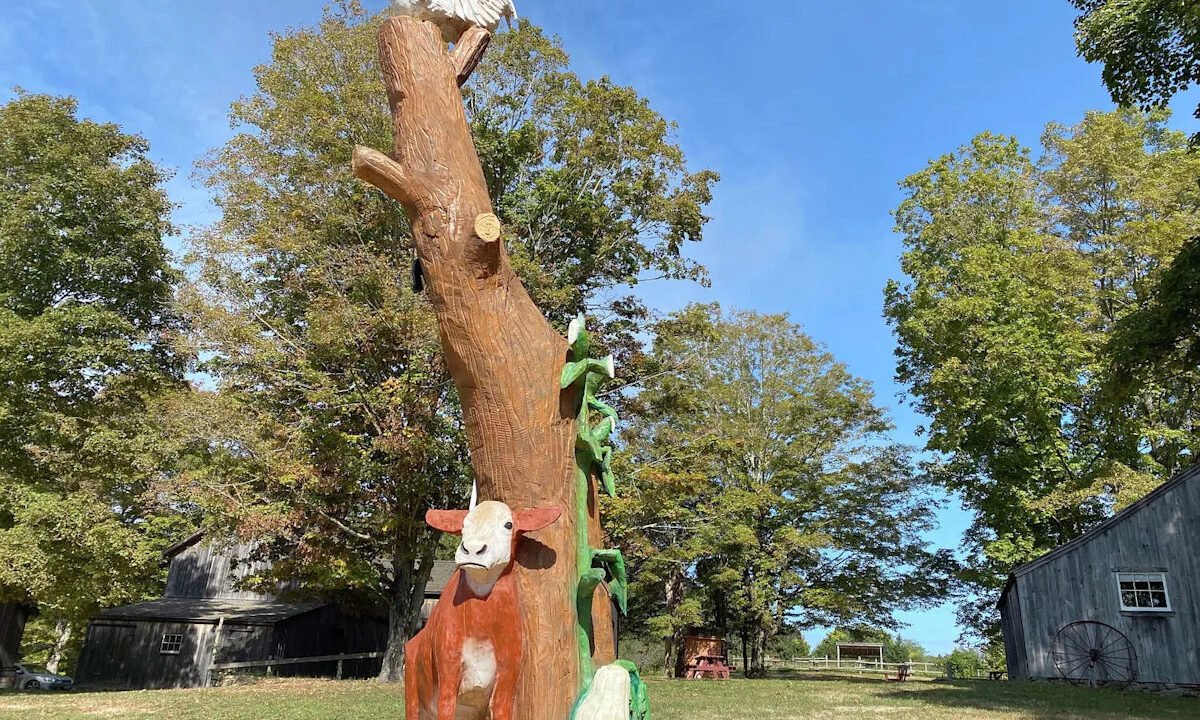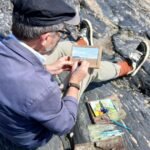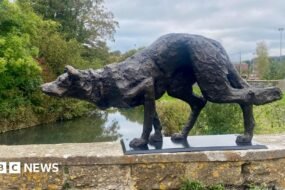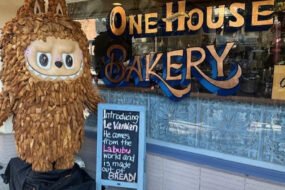
GUILFORD – The 150-year-old maple tree at the Dudley Farm Museum had a long life. Little ones played on a rope swing hung from its branches and sap was tapped during maple sugaring season.
But members of the museum’s board of directors became concerned when the venerable tree became diseased and was dying.
The old maple was recently transformed into a tree sculpture – its branches and trunk carved up with a chainsaw and Dremel into a kind of totem pole to celebrate the museum’s agricultural heritage. It’s now named The Giving Tree.
Colorful farm animals and plants seem to pop out of the 12-foot-tall tree stump, that is still rooted in a corner of the farm, fronting Route 77 in North Guilford.
Hamden chainsaw artist Jared Welcome of JareBear Carvings created the sculpture in little over a week.
Welcome has created chainsaw sculptures from living, downed or dead trees – even ones still standing – across the state for museums, parks, churches and even homeowner’s front yards. And he’s fashioned many different figures out of wood.

A black bear Jared Welcome made for the Bristol Mum Festival. (Courtesy Jared Welcome)
“I’ve done people’s dogs, and I do them from 6-inches tall all the way up to like the Dudley Farm Museum one,” said Welcome.
Welcome recently completed a black bear holding a welcome sign and in the other paw, a solar powered lantern, for the Mum Festival in Bristol, Sept. 26.
He has created owls, eagles, cardinals and even a “wee faerie house” in a live tree at the Florence Griswold Museum, for their Wee Faerie Village event, a few years ago. The tree had since been cut down, but the “house” was sold at auction.
There is not much wiggle room for mistakes when working on a tree still rooted, like the one at Dudley Farm, Welcome said.
“You get one chance at those,” Welcome said.
It’s much different than when he creates a sculpture from a free-standing log in his Hamden studio. When he makes a mistake there, he can always start over on a new log if need be.
While the Dudley museum board members came up with a design, they learned they would have to give Welcome creative license since he wasn’t sure what he’d find when he started to cut into the dying maple.
Board member Mary Norris is the one who came up with the idea to turn the dying tree into art and contacted the wood carver.
Welcome first set up his scaffolding around the tree, then he got up close and analyzed the stump.
“We had a plan of what we wanted it to look like, but the tree had so much rot that, you know, the plans change,” Welcome said.
But the leafless stump was in good hands, the board agreed.
“And they trusted me to do something beautiful with the same principles, the same animals and the same things in mind,” Welcome said.
Welcome, who said he is not skilled at drawing or painting, does a rough sketch and visualizes the figures in the tall stump before he cuts.
Welcome was pleased with the end result at the farm.
In the sculpture, a rooster with a bright red comb perches at the very top while a spotted Hereford calf, modeled after one that grazes at a nearby farm, stands at the bottom on the stump.
A set of carved horseshoes that appear to hang from one side may seem like a minor detail but reflect the farm’s past.
“They had draft horses here, way back in the day,” explained museum board member Jerri Guadagno.
As a nod to the area’s Native American roots, cornstalks appear to climb the back of the maple among leafy squash plants. The Quinnipiac Dawnland Museum is also on the property.
But for some board members, their favorite part of the tree carving is the rooster.
“The rooster on the top is really just kind of symbolic of dawn on the farm and kind of awakening the land,” said board member Sharon Bloom.
Bill Black, also on the museum board, marveled at the detail in the rooster.
“I think the interesting thing … is that he just didn’t make a rooster and stick it on the top,” Black said. “He carved it out of the tree itself.”
Welcome said most people are curious about how he got into tree carving. He said he grew up near woodlands and his parents had given him “an old beat-up” chain saw one Christmas while in high school.
Some 13 years ago he decided to try his hand at tree carving.
“I did my first carving and then somebody bought it and … it was horrible,” he recalled with a laugh. “And then I just started liking doing it and then I was just trying to do it.”
The extra little bit of money, Welcome said would help him cover his monthly car payment.
Welcome said he does tree carving now out of love. He teaches manufacturing at MacDougall-Walker Correctional Institution in Suffield in his day job.
“I do it because I love it,” Welcome said. “And I can take my time and I’m not in a rush.”
Black is a fan of Welcome’s work.
“I love seeing those tree sculptures,” he said. “I don’t know what it is. And I think the kids love it.”
Visitors to the farm may take part in a contest to name the calf in the tree, along with guessing the weight of a giant pumpkin as part of Dudley Farm’s annual Harvest Day celebration from 10 a.m. to 2 p.m. on Oct. 18. Other family friendly activities, as well as old-time craft demonstrations and a farmer market will also take place.
This article originally published at A Hamden artist turned a dying tree into a sculpture at Guilford’s Dudley Farm Museum.









